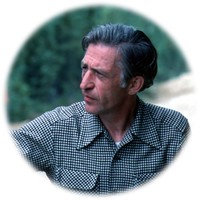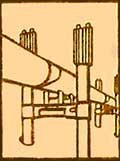
Harold Ray "Hal" Peyton
March 25, 1928 - March 16, 1977
Hal Peyton services today. Funeral services were at 10 a.m. today in Anchorage for Dr. Harold "Hal" Peyton, 48, who died Wednesday. He had lived in Fairbanks for three years.
Peyton was a professor of engineering at the University of Alaska-Fairbanks for three years. At the time of his death he was employed by Atlantic Richfield as a senior staff engineer. He also was a consultant with Alyeska and its predecessor the Trans-Alaska Pipeline System. Dr. Peyton held a variety of engineering positions with Alyeska with emphasis on Arctic problems.
He lived on the North Slope for four years in the late 1950's and early 1960's. He held a doctor of philosophy degree in engineering from the University of Ohio.
He is survived by his wife, Betty of Anchorage-, his parents, Cale and Doris Peyton of Klamath Falls, Ore.; three sons, Paul of Silica, and Jeffrey and Scott of Newburg, Ore.; a daughter, Linda Grady of San Diego, Calif., and two step-children, Mark and Vicki of Anchorage.
The family requests that contributions be made to the Harold Peyton Memorial Scholarship Fund for engineering students at the University of Alaska, Fairbanks
Published in the Fairbanks Daily News-Minor, March, 19 1977
Special thanks to Howard Thomas for sharing the above photo


Howard Thomas
I was fortunate to have worked closely with Dr. Peyton on design and construction of the pipeline from 1970 until he died not long before pipeline startup. A true Cold Regions Engineering Pioneer, Hal played a major role as Chief Engineer on design and construction of the TAPS. His role on the project included providing crucial testimony during project permit hearings.
Proir to TAPS, Hal conducted extensive research on mechanical properties of sea ice, designed and developed the first university arctic cold laboratory, and served as Principal Consultant on ice forces for the first permanent oil platform in the Cook Inlet. In addition, he was one of the originators of the first academic course in in Arctic Engineeering.
To honor Dr. Peyton's outstanding professional accomplishments and stimulate awareness and interest in the challenges of Cold Regions Engineering, the American Society of Civil Engineers established the Harold R. Peyton Award for Cold Regions Engineering in 1988. The award has been made to 28 well-qualified ASCE members since then.
Bill Howitt
I can't quote Hal Payton verbatim, but one of my favorites of all the wise things he said was, "Unless you balance the thermal equation, mother nature will do it for you...and you won't like the results."
Elden Johnson
Hard to believe Hal was only 48 when he died. A young man by current context but wise beyond his years even then. And yes, always the Mentor as Bill notes, he gave Sage advice to Engineers both young and old --- "you better balance the _________ equation or Mother Nature will do it for you". Pertains to any number of engineering calclations.
Jim Foerstner
I too had the opportunity to observe and work with Hal. He was an amazing person, so knowledgeable, yet approachable. He had the most unusual ability to expain complicated engineering issues & solutions to sometimes disdainful and disapproving construction managers. I loved having him alongside me in meetings. No one better nor more supportive. He death was the saddest point in construction, especially so in that he would never experience "oil in", nor experience the great credit he so deserved.
RIP Hal. You will always be a friend to those with the opportunity to experience your brilliance.
Ed Clarke
Ed Clarke
I was a student employee in the Cold Lab at UAF started by Hal Peyton in the late 60s. This had two chambers that could reach -60 F which were used for cold weather experiments. During this period Hal provided ice strength information for oil platforms in Cook Inlet, which enhanced his reputation as an arctic expert. After going to work for Exxon, I think Hal faced one of the biggest chalanges of his career when he told the pipeline owners to accept the changes required by the Department of the Interior. I went to work on the pipeline as a consultant in Houstion and after returning to alaska was field engineering supervisor in section 5/ 6. I later worked with Hal Peyton and Jim McPhail on the traveling to all the section headquarters to hear contractors requests for engineering changes and tracking these changes. We lost Hal just as the pipeline neared completion.
During his work at Alyeska, Hal produced a movie that explained permafrost and how a pipeline could be constucted thought it in a safe and environmentally sound manner. This video serves as a wonderful piece of education for people who are so concerned about how a pipeline can be responsible for the wildlife and land. The Structures and Foundation Committee of the Cold Regions Engineering Division of the American Society of Civil Engineers is looking at ways to update this movie.